Standard Chartered Bundle
Can Standard Chartered Navigate the Future of Global Finance?
Standard Chartered, a banking giant with over 160 years of history, is charting a course through the ever-changing financial landscape. From its roots facilitating trade to its current global presence, the bank's evolution reflects its adaptability. Understanding the Standard Chartered SWOT Analysis is key to grasping its strategic direction.
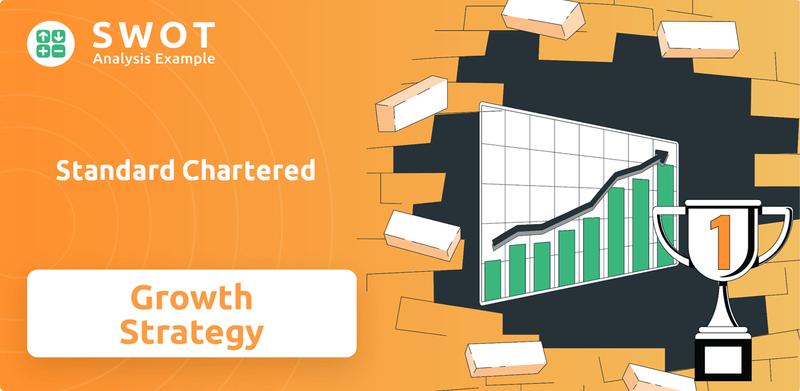
This exploration delves into Standard Chartered's growth strategy, examining its strategic initiatives for 2024 and beyond, and assessing its future prospects within the banking industry. We'll analyze its market share, financial performance, and expansion plans, particularly in emerging markets like Africa and Asia, considering the impact of global economic conditions. The analysis covers the bank's investment strategy, digital transformation, and competitive landscape, alongside its sustainability goals and risk management strategy, providing a comprehensive SCB company analysis.
How Is Standard Chartered Expanding Its Reach?
The company is actively pursuing several expansion initiatives, with a strong emphasis on enhancing its wealth management capabilities. This strategic direction is supported by significant investments and a focus on key emerging markets. The goal is to capitalize on growth opportunities and strengthen its position in the financial services sector.
A key element of the expansion strategy involves increasing its presence in wealth management. This includes establishing new wealth management centers and expanding its network in strategic locations. These initiatives are backed by substantial investments aimed at attracting new assets and achieving significant growth in income from wealth solutions.
Geographically, the company is also considering expanding into new markets, such as Morocco, as part of its Africa growth strategy. This expansion is part of a broader plan to capitalize on opportunities in the region and enhance its wealth management and transaction banking businesses.
The establishment of its sixth wealth management center in Hong Kong is a key initiative. This expansion aims to attract substantial new assets. The company is expanding its network of cross-border wealth management centers, with existing locations in Taiwan and Shanghai.
A $1.5 billion investment plan, announced in December 2024, supports the affluent banking segment. The goal is to secure $200 billion in net new money. The company aims to achieve double-digit annual growth in income from its wealth solutions over the next five years.
The company is exploring expansion into Morocco as part of its Africa growth strategy. This strategy builds on its commitment to North African expansion, with a branch opened in Egypt in January 2024. The bank is capitalizing on the departure of other global competitors from the continent.
The company is divesting from smaller operations in markets like Zimbabwe and Angola. It is also exploring the sale of retail banking units in Botswana, Uganda, and Zambia. The company partnered with British International Investment (BII) in May 2025.
The company's expansion strategy includes significant investments in wealth management, geographic diversification, and strategic partnerships. These initiatives are designed to drive growth and enhance its market position. These plans are part of the overall Target Market of Standard Chartered strategy.
- Focus on wealth management with new centers and significant investments.
- Expansion into key emerging markets, including potential entry into Morocco.
- Strategic divestitures to focus on core growth markets and cross-border services.
- Partnerships to support trade finance and business growth in Africa.
Standard Chartered SWOT Analysis
- Complete SWOT Breakdown
- Fully Customizable
- Editable in Excel & Word
- Professional Formatting
- Investor-Ready Format
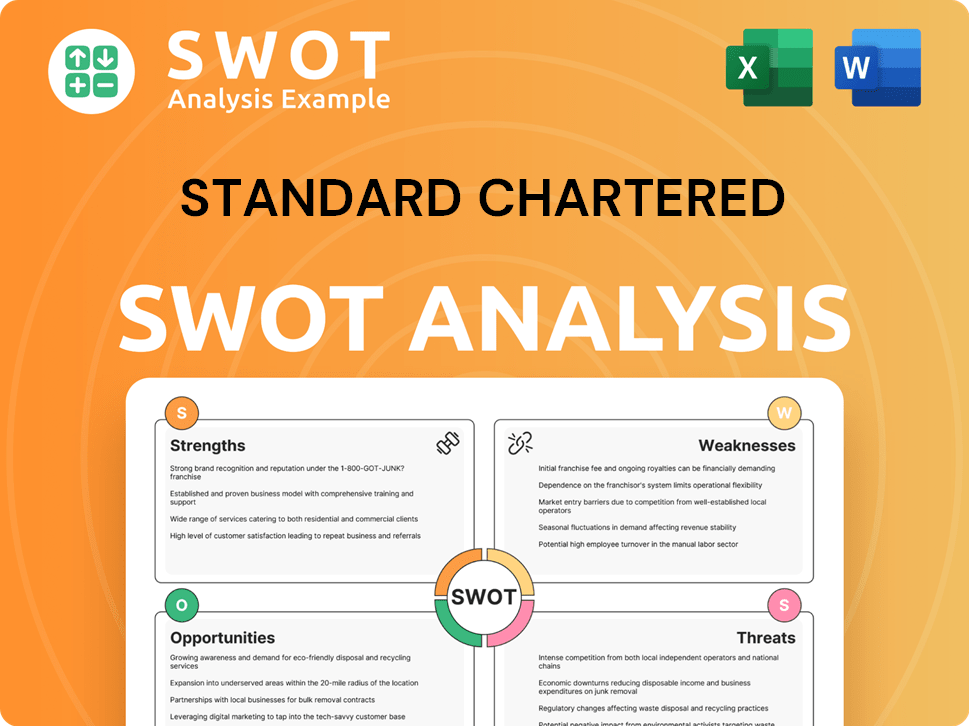
How Does Standard Chartered Invest in Innovation?
The innovation and technology strategy of Standard Chartered is central to its growth, focusing on digital transformation, AI integration, and sustainable finance. This approach allows the bank to adapt to evolving customer needs and preferences in the rapidly changing financial landscape. The bank's strategic initiatives are designed to enhance customer experience and drive operational efficiency.
Standard Chartered is committed to leveraging technology to improve client experiences and drive new opportunities. This commitment is evident in its investments in digital channels, AI, and sustainable finance. These efforts align with the banking industry trends, which emphasize digital-first approaches and data-driven decision-making.
The bank's future prospects are closely tied to its ability to execute these strategies effectively, particularly in emerging markets. By focusing on innovation and technology, Standard Chartered aims to strengthen its competitive position and deliver long-term value to its stakeholders. The Brief History of Standard Chartered provides context for understanding the bank's evolution and its current strategic direction.
Standard Chartered is developing a formal AI strategy, scheduled to be presented to its board in mid-2025. This strategy focuses on using AI to achieve business goals, particularly in serving affluent and cross-border clients and supporting sustainability. Mohammed Rahim, the group chief data officer, appointed in December 2024, is leading these initiatives.
The bank is establishing a central AI platform and enhancing its data platform. A central team is responsible for building AI guardrails, including responsible AI frameworks. This infrastructure supports the scaling and governance of AI initiatives across the organization.
SC GPT, an internal large language model similar to ChatGPT, has been rolled out globally to 70,000 employees across 41 markets. This tool has already handled over 150,000 prompts, demonstrating its utility in internal operations. The bank is also forming generative AI (GenAI) squads.
Standard Chartered is refreshing its responsible AI framework to address challenges posed by GenAI, agentic AI, and open-source models. This includes mitigating biases and addressing security risks. The bank is also working to uplift AI literacy across its workforce through initiatives like 'promptathons.'
Standard Chartered aims to be a digital-first and data-driven bank. Key initiatives include VietQR scanning and 24/7 payment options through its Virtual Account and Straight2Bank Pay solutions. The bank is expanding APIs to streamline business processes, particularly in Vietnam.
Mobile banking is a primary digital channel for Standard Chartered, with an 84% usage rate and 98% mobile penetration rate in Vietnam. This highlights the importance of mobile technology in the bank's digital strategy. The bank is also investing in emerging technologies.
Standard Chartered is investing in emerging technologies like blockchain, quantum computing, and tokenization to create a more integrated financial ecosystem. These investments are aimed at enhancing efficiency and security in financial transactions. The bank's commitment to sustainable finance is also a key aspect of its innovation strategy.
- Blockchain and Partnerships: Standard Chartered partnered with DBS and JPMorgan to develop Partior, a blockchain-based payments clearing and settlement network.
- Sustainable Finance: In 2024, sustainable finance generated $982 million in income, a 36% increase from the previous year. The bank aims to reach $1 billion by 2025.
- Sustainable Finance Mobilization: Standard Chartered has pledged to mobilize $300 billion in sustainable finance by 2030, having already reached $121 billion by the end of 2024.
- Digital Expansion: The bank's digital transformation efforts, including mobile banking and API expansion, are crucial for its expansion plans in key markets.
Standard Chartered PESTLE Analysis
- Covers All 6 PESTLE Categories
- No Research Needed – Save Hours of Work
- Built by Experts, Trusted by Consultants
- Instant Download, Ready to Use
- 100% Editable, Fully Customizable
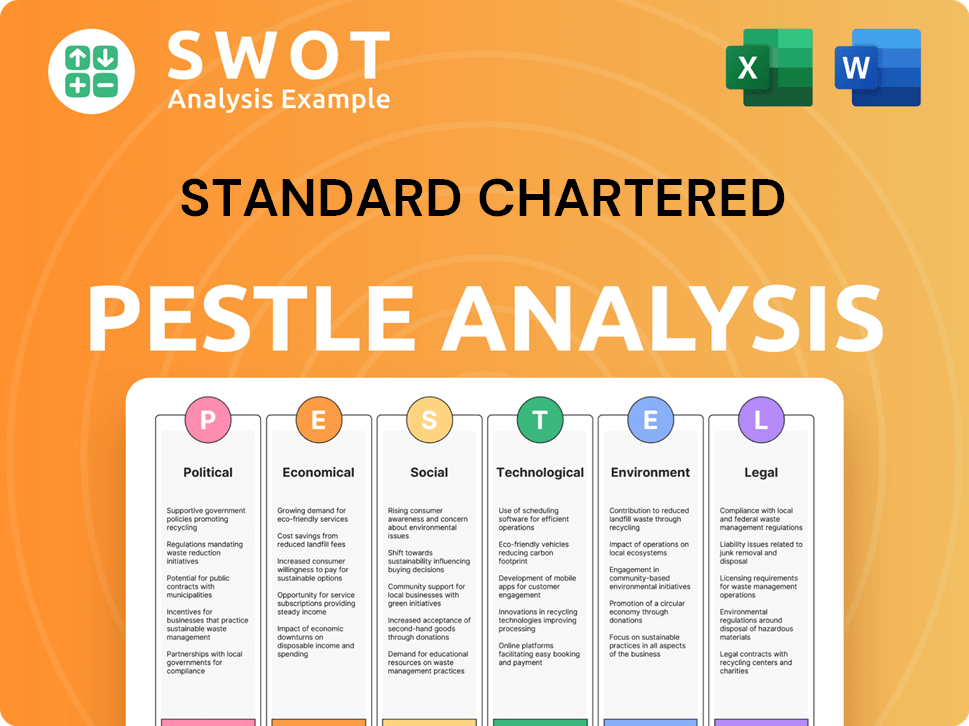
What Is Standard Chartered’s Growth Forecast?
The financial outlook for Standard Chartered (SCB) is robust, underpinned by strong performance in 2024 and a positive trajectory into 2025. The bank's strategic initiatives and focus on key segments have driven significant financial gains, positioning it favorably within the Revenue Streams & Business Model of Standard Chartered.
In 2024, SCB achieved record operating income and substantial profit growth, reflecting effective execution of its strategies. The bank's performance in Q1 2025 further solidifies this positive outlook, with increases in operating income and profit before taxation. These results highlight SCB's ability to navigate global economic conditions and capitalize on opportunities in the financial services sector.
SCB's financial performance in 2024 was marked by several key achievements. The bank reported a record operating income of $19.7 billion. Profit before tax surged by 21% to $6.8 billion. The return on tangible equity (RoTE) increased to 11.7%, a 160 basis point rise year-on-year. Net interest income (NII) reached $10.4 billion, up 10%, while non-NII increased by 20%. The bank also announced a $1.5 billion share buyback and a proposed final dividend of 28 cents per share.
In Q1 2025, SCB's operating income reached $5.4 billion. Profit before taxation increased by 10% year-over-year to $2.103 billion, up from $1.91 billion in Q1 2024. Profit attributable to shareholders rose 13% to $1.59 billion. Earnings per share were up 19%, driven by double-digit income growth in wealth solutions, global markets, and global banking.
Total shareholder distributions since the full-year 2023 results reached $4.9 billion, demonstrating SCB's commitment to returning value to shareholders. The bank is well on track towards its target of at least $8 billion in total distributions.
SCB expects its sustainable finance income to reach nearly $1 billion by 2025, a year ahead of its initial target of 2026. This highlights the bank's commitment to sustainability goals and its ability to integrate sustainable practices into its business model.
The bank aims to achieve net zero in its Scope 1 and 2 emissions by 2025. This commitment underscores SCB's dedication to environmental responsibility and its proactive approach to reducing its carbon footprint.
SCB maintains an optimistic economic outlook for 2025, predicting stable global growth at 3.1% from 3.2% in 2024, despite slight slowdowns. This positive outlook supports the bank's growth strategy and its ability to capitalize on opportunities in emerging markets expansion.
Net interest income (NII) reached $10.4 billion, up 10% in 2024, indicating a strong performance in core banking activities. This growth in NII is a key driver of SCB's overall financial success and contributes to its profitability drivers.
SCB's focus on digital transformation strategy is expected to enhance its operational efficiency and improve customer experience. Digital initiatives are crucial for maintaining a competitive edge in the banking industry trends.
Double-digit income growth in wealth solutions during Q1 2025 highlights the success of SCB's strategic focus on high-growth areas. This growth contributes significantly to the bank's overall financial performance and customer acquisition strategies.
Double-digit income growth in global markets during Q1 2025 demonstrates SCB's strong position in international financial markets. This performance is a key indicator of the bank's ability to navigate and succeed in a competitive landscape.
Double-digit income growth in global banking during Q1 2025 underscores the bank's strength in serving its international client base. This growth is a testament to the effectiveness of SCB's Standard Chartered growth strategy and its focus on key markets.
Standard Chartered Business Model Canvas
- Complete 9-Block Business Model Canvas
- Effortlessly Communicate Your Business Strategy
- Investor-Ready BMC Format
- 100% Editable and Customizable
- Clear and Structured Layout
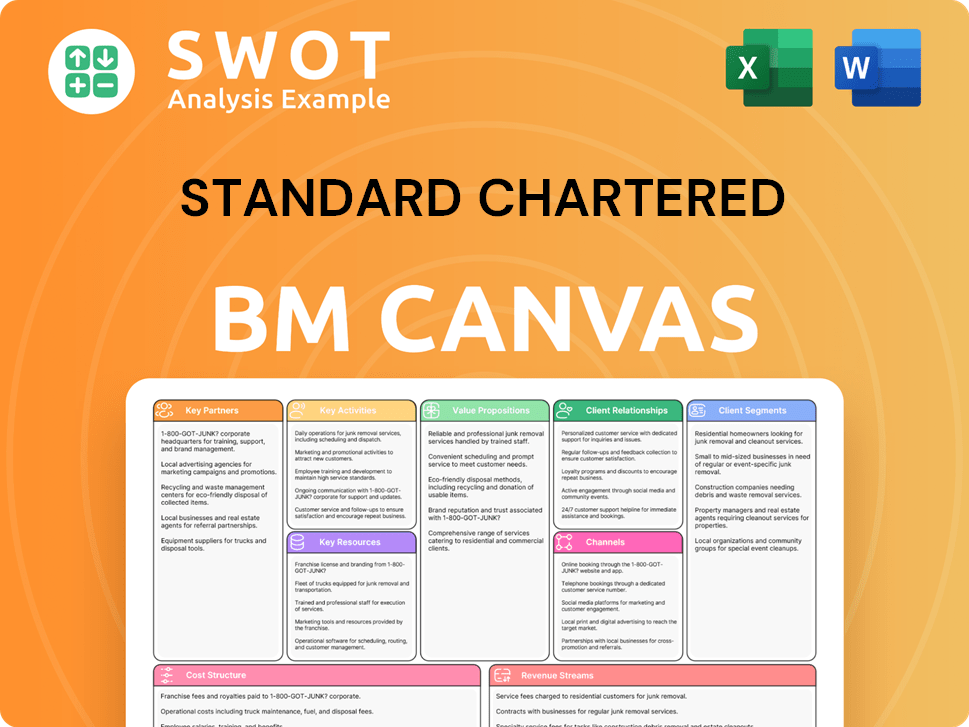
What Risks Could Slow Standard Chartered’s Growth?
The future prospects of the company, and its ambitious growth strategy, are subject to various risks and obstacles. These challenges span market competition, regulatory changes, and geopolitical uncertainties. Understanding these potential pitfalls is crucial for investors and stakeholders assessing the long-term viability of the company's strategic initiatives.
The company's operations across numerous jurisdictions expose it to diverse regulatory frameworks, with evolving standards in areas like AI adding complexity. Furthermore, geopolitical and macroeconomic factors, including potential US election outcomes and the ongoing Russia-Ukraine situation, introduce significant risks that could impact global growth and, consequently, the company's financial performance. The company's strategic initiatives are also influenced by internal resource constraints and technological disruptions.
The company's digital transformation and AI integration require substantial investment in talent and infrastructure. The effective implementation of these technologies, along with managing potential biases and security risks, is critical. The company also faces challenges related to sustainable finance, particularly navigating complex environmental, social, and governance (ESG) factors and associated regulatory expectations. For detailed insights into the company's ownership structure, explore the analysis provided in Owners & Shareholders of Standard Chartered.
The Standard Chartered growth strategy faces persistent challenges from competitors in key regions and product categories. The financial services outlook is competitive, requiring continuous innovation and strategic adaptation. The company's ability to maintain and grow its market share is crucial for its future prospects.
Evolving regulations, particularly in emerging technologies like AI, pose a significant obstacle. These changes can lead to fragmented regulations, increasing complexity and costs. The company actively responds to consultations to mitigate potential market friction and ensure compliance with banking industry trends.
Geopolitical and macroeconomic uncertainties present ongoing risks to the company. The 2025 outlook acknowledges potential impacts from the US election, including tariffs on key trading partners. The Russia-Ukraine situation also poses risks, particularly for Europe. These factors influence Standard Chartered financial performance review.
The company's ambitious digital transformation and AI integration strategies require substantial investment in talent and infrastructure. Ensuring effective implementation and managing associated risks are crucial. These constraints can impact the pace of Standard Chartered digital transformation strategy.
The rapid pace of technological advancements in the financial sector necessitates continuous adaptation and investment. The company must navigate potential disruptions from fintech companies and other innovations. This affects the Standard Chartered competitive landscape.
Navigating complex environmental, social, and governance (ESG) factors and associated regulatory expectations is essential. Despite peers reevaluating climate commitments, the company is advancing its environmental objectives, aiming to mobilize $300 billion in sustainable finance by 2030. This aligns with Standard Chartered sustainability goals.
Global economic and geopolitical complexity increases market volatility, impacting the company's ability to help clients manage their business and wealth across borders. This volatility can affect Standard Chartered investment strategy and overall returns. The company must navigate these conditions to maintain its financial performance.
Expansion into new markets, particularly in Africa, involves inherent risks such as political instability and economic fluctuations. These factors can impact the success of Standard Chartered expansion plans Africa. The company must carefully assess and manage these risks to ensure sustainable growth.
Effective risk management is critical in mitigating the potential impact of various challenges. This includes managing credit risk, market risk, and operational risk. Proper risk management strategies are essential for the company's long-term success and Standard Chartered risk management strategy.
The company's ability to maintain and improve profitability depends on several factors, including efficient operations, effective cost management, and successful customer acquisition. Understanding these Standard Chartered profitability drivers is essential for assessing its financial health. The company is focused on enhancing its returns.
Standard Chartered Porter's Five Forces Analysis
- Covers All 5 Competitive Forces in Detail
- Structured for Consultants, Students, and Founders
- 100% Editable in Microsoft Word & Excel
- Instant Digital Download – Use Immediately
- Compatible with Mac & PC – Fully Unlocked
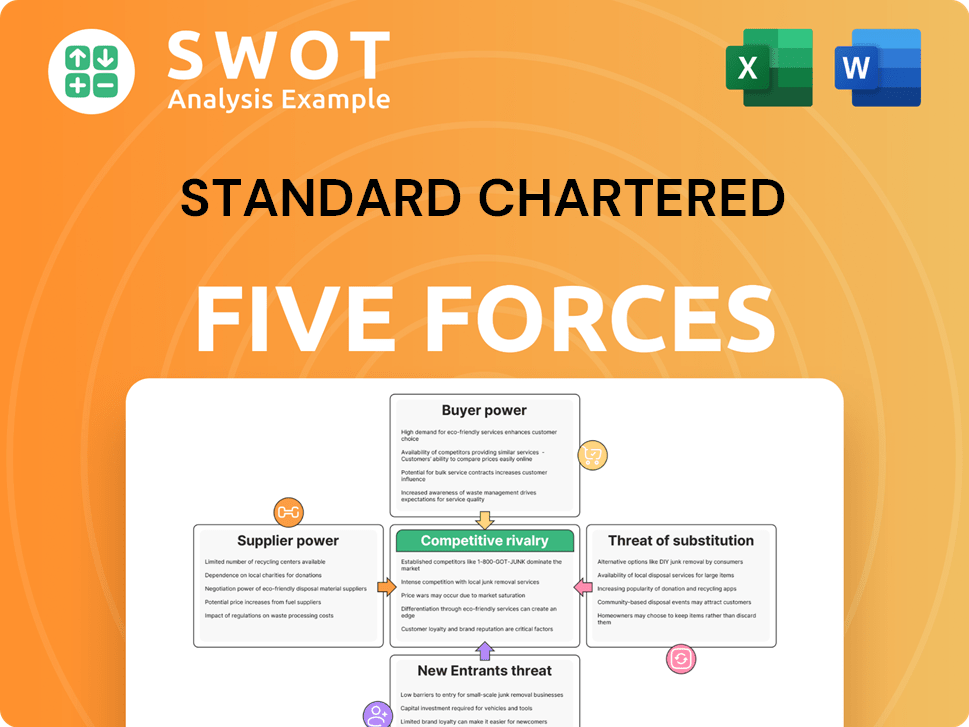
Related Blogs
- What are Mission Vision & Core Values of Standard Chartered Company?
- What is Competitive Landscape of Standard Chartered Company?
- How Does Standard Chartered Company Work?
- What is Sales and Marketing Strategy of Standard Chartered Company?
- What is Brief History of Standard Chartered Company?
- Who Owns Standard Chartered Company?
- What is Customer Demographics and Target Market of Standard Chartered Company?
Disclaimer
All information, articles, and product details provided on this website are for general informational and educational purposes only. We do not claim any ownership over, nor do we intend to infringe upon, any trademarks, copyrights, logos, brand names, or other intellectual property mentioned or depicted on this site. Such intellectual property remains the property of its respective owners, and any references here are made solely for identification or informational purposes, without implying any affiliation, endorsement, or partnership.
We make no representations or warranties, express or implied, regarding the accuracy, completeness, or suitability of any content or products presented. Nothing on this website should be construed as legal, tax, investment, financial, medical, or other professional advice. In addition, no part of this site—including articles or product references—constitutes a solicitation, recommendation, endorsement, advertisement, or offer to buy or sell any securities, franchises, or other financial instruments, particularly in jurisdictions where such activity would be unlawful.
All content is of a general nature and may not address the specific circumstances of any individual or entity. It is not a substitute for professional advice or services. Any actions you take based on the information provided here are strictly at your own risk. You accept full responsibility for any decisions or outcomes arising from your use of this website and agree to release us from any liability in connection with your use of, or reliance upon, the content or products found herein.